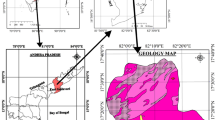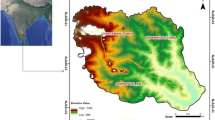Abstract
Remote sensing techniques has proved to be an extremely useful tool in morphometric analysis and groundwater studies. Remote sensing techniques with an emphasis on lineament identifications can play a great role in groundwater prospecting in semi-arid hard rock areas of Purulia district. In the present study, morphometric analysis using remote sensing technique has been carried out in parts of Baghmundi block, Purulia district, West Bengal. The parameters worked out include Bifurcation ratio (Rb), Stream length (Lu), Form factor (Rc), Circulatory ratio (Rc), and Drainage density (D). The morphometric analysis suggests that fractured, resistant, permeable rocks cover the area, the drainage network not so affected by tectonic disturbances. Using satellite imageries of two dates of IRS, different hydrogeomorphological units have been delineated. Among different hydrogeomorphic units (i) very shallow weathered pediment and (ii) Structural hills/ residual hills/inselbergs have very poor ground water prospects, while moderately weathered pediplains and valley fills are good prospective zones for groundwater exploration.
Similar content being viewed by others
References
Astras, T. and Soulankellis, N. (1992). Contribution of digital image analysis techniques on Landsat-5 TM imageries for drainage delineation. A case study from the Olympus mountain, west Macedonia, Greece. Proc. 18th annual conf. Remote Sens. Soc, Univ of Dundee, pp. 163–172.
Derbyshire, E., Gregory, K. J. and Hails, J. R. (1981). Studies in physical geography, geomorphological processes. Butterworths, London, 101 p.
Doornkamp, J.C and A M K Cuchlaine. (1971). Numerical Analysis in Geomorphology - An Introduction. Edward Arnold, London, pp 3–20.
Horton, R. E. (1945). Erosional development of streams and their drainage basins: hydrophysical approach to quantitative morphology. Bull. Geol. Soc. Amer., 56: 275–370.
Integrated Mission for Sustainable Development. Tech. Report on Baghmundi Block, Puruliya District, West Bengal (1996). (unpublished)
Leopold, L. B. and Miller, J. P. (1956). Ephimeral streams: hydraulic factors and their relation to the drainage net. U. S. Geol. Surv. prof., Pap 282-A.
Melton, M. A. (1957). An analysis of the relations among elements of climate, surface properties and geomorphology. Proj. NR 389-042, Tech. Rep 11, Columbia University, Department of Geology, ONR, New York.
Morisawa, M. E., (1959). Relation on morphometric properties to runoff in the Little Mill Creek. Ohio, drainage basin. Tech. Rep. 17, Columbia University, Department of Geology, ONR, New York.
Schumm, S. A. (1956). Evolution of drainage systems and slopes in bad lands at Perth Amboy. New Jersey, Bull. Geol. Soc. Am., 67: 597–646.
Strahler, A. N. (1952). Dynamic basis of geomorphology. Bull. Geol. Soc. Amer., 63: 923–938.
Strahler, A. N. (1957). Quantitative analysis of watershed geomorphology. Trans. Amer. Geophys. Union, 38, 913–920.
Strahler, A. N. (1964). Quantitative geomorphology of drainage basin and channel networks. In: V. T. Chow (ed), Handbook of Applied Hydrology, McGraw Hill, New York, section 4-11.
Author information
Authors and Affiliations
About this article
Cite this article
Nag, S.K., Chakraborty, S. Influence of rock types and structures in the development of drainage network in hard rock area. J Indian Soc Remote Sens 31, 25–35 (2003). https://doi.org/10.1007/BF03030749
Received:
Revised:
Issue Date:
DOI: https://doi.org/10.1007/BF03030749




